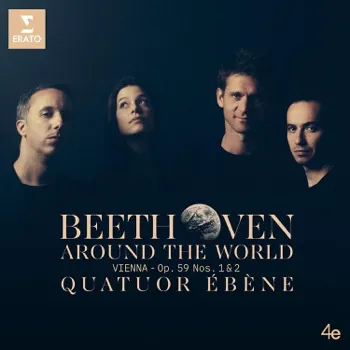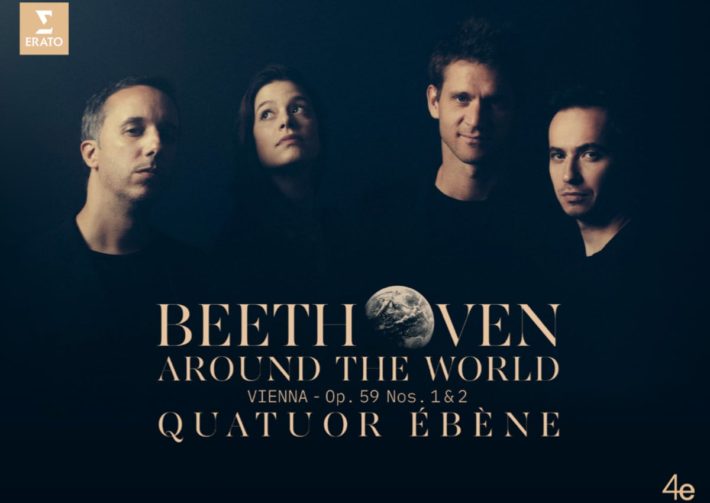Quatuor Ébène begin their Beethoven complete String Quartets cycle with two of the “Rasumovsky” Quartets, Op. 59 No. 1 and 2.
Quatuor Ebene writes that early on in their quartet’s life, when they were still in the conservatory, they were like “an infant…bottle-fed on Ravel and Schubert”. They sound a touch apologetic, but they needn’t be; Ravel and Schubert are as good a starting place as any, as evidenced by the quartet’s characteristic, rich and unified tone. Their early discography was often no meatier but offered them further chances to develop different sound worlds; to Ravel, they added Debussy and Fauré, to Schubert they added Mozart and Mendelssohn, and two albums of popular music, one with tracks from movie scores and one centered around Brazilian tunes. The quartet brings all this preparation to bear on two of Beethoven’s middle string quartets in their newest release.

Beethoven’s String Quartet No. 7 (Op. 59 No. 1), the first of the “Rasumovsky” set, is notoriously difficult to interpret and perform, but the Quatuor Ebene gives a wonderfully original and varied account of the piece. Their use of vibrato is particularly noteworthy. It’s very subdued throughout the opening, which gives the first theme a very nonchalant feel, as if you’re strolling down a city street. But then, when the second theme rolls around (track 1, 1’33”), suddenly a warm vibrato pervades every note; we’ve entered a luxuriously decorated building, perhaps.
Throughout the development, the quartet employs non-vibrato playing to great effect, for instance when they pass around diminished chords, searching for a stable sonority (3’42”). After finding one, it’s non-vibrato again to accompany a simple eighth-note figure in the violin. They are not the first quartet to use non-vibrato in Beethoven, but the artistry with which they use it to sculpt the music’s emotion, with the octaves perfectly in tune, with the right amount of silence between notes, sets the bar very high.
In the piece’s Scherzo, the quartet shows off their ability to change the mood of their playing on a dime, shifting quickly from quiet and calm to aggressive and back within seconds. Plenty of cadences feature these shifts (a good instance appear at 0’29”), and it is more than dynamics that change; the articulation of the notes, and their duration, change too. The result is a pleasure to listen to. The Russian theme in the Finale is played well in all its different styles — spoken, whispered, drawn-out and sung — in a rousing close to the quartet.
In the second “Rasumovsky” quartet (Op. 59 No. 2), the stylistic virtuosity continues, though the music feels slightly less suited to it. The first movement’s main theme is inherently full of contrast, and the quartet loses no chance to highlight that. The quiet moments almost give you shivers. But the movement as a whole might actually demand a more unified, less determined sound. The music ventures so hesitantly into major keys, one doesn’t really believe it; to hear Ebène play it with such enthusiasm isn’t quite convincing.
The quartet’s adagio is somehow lacking solidity; The quartet’s adagio is somehow lacking solidity. Ebène’s default adagio sound is ethereal, with soft attacks and ever-evolving vibrato, but one almost wishes for a less sophisticated, more direct sound, like that heard in Quartetto Italiano or the Takác’s Quartet’s versions. The following scherzo sounds strange played as legato as they do here; the finale is more comfortable in its skin, the dance-like Rondo bouncing along happily. As with all Beethoven, these are issues of taste. The performance is very high quality regardless.
This Razumovsky set compares favorably to well-worn recordings of the quartets, especially if you like your Beethoven on the Romantic side. Quartetto Italiano’s version can feel restrained and stiff after hearing Ebène’s version; it’s certainly seated more firmly in a Classical tradition. Recorded both live and on rehearsal in Vienna, the sound of the album is clean and of high quality, though the Ebènes continue their practice of capturing the sounds of their breath as they play.
This set of recordings leaves us eager to hear the rest of the cycle. It will be interesting to hear how the group’s approach to Beethoven changes as they leave Ravel and Schubert even further behind.
“Beethoven Around the World”
Beethoven – String Quartets No. 7 & 8, Op. 59 No. 1 & 2 (“Rasumovsky”)
Quatuor Ebene
Erato / Warner Classics, CD 190295396022




















